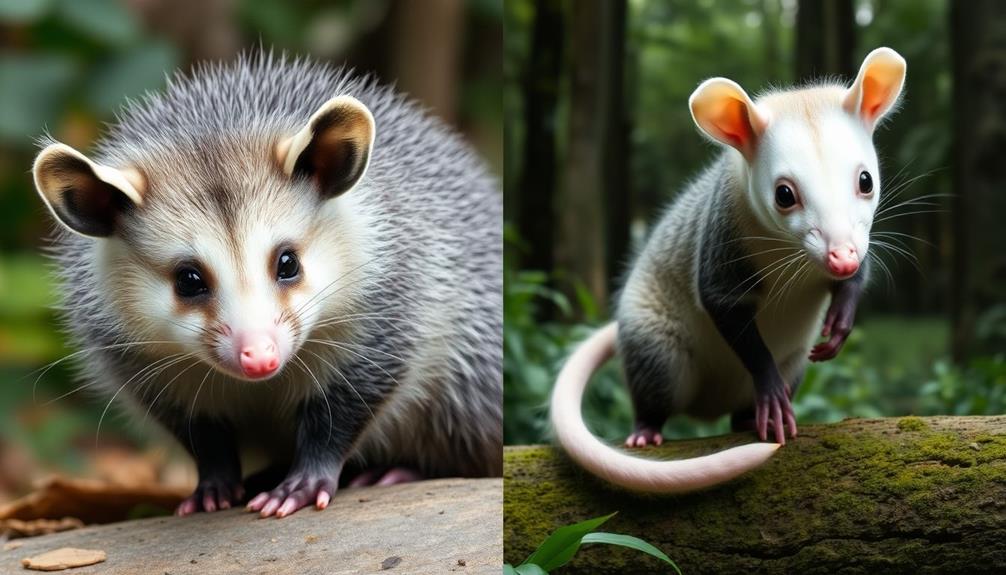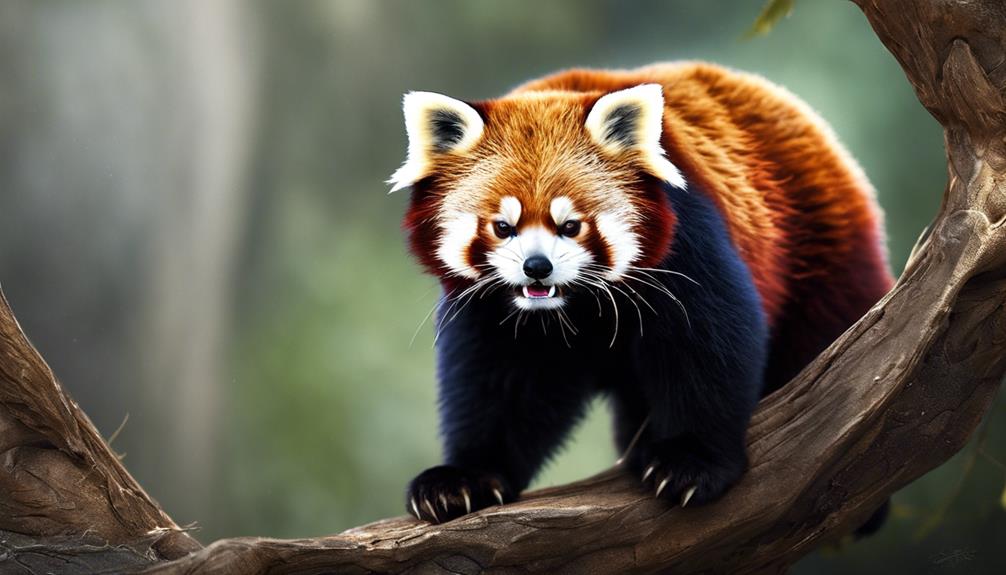When you compare possums and opossums, you'll notice key differences. Possums, native to Australia and nearby regions, are marsupials with rounded faces and prehensile tails. In contrast, opossums, like the Virginia opossum, belong to North America and have pointed faces with long, hairless tails. They also differ in diet; possums primarily eat plants while opossums are omnivorous scavengers. Understanding these distinctions is essential for recognizing their roles in their ecosystems. With a little more exploration, you can uncover even more fascinating facts about these unique creatures and their importance in the animal kingdom.
Key Takeaways
- Possums are native to Australia and surrounding regions, while opossums, particularly the Virginia opossum, are found in North America.
- Possums belong to the order Diprotodontia, while opossums fall under Didelphimorphia, reflecting their different evolutionary paths.
- Possums have rounded faces and prehensile tails, whereas opossums have pointed faces, elongated snouts, and hairless tails.
- Possums are primarily herbivorous, while opossums are omnivorous, consuming a wider variety of food, including carrion.
- Correct terminology is essential; "opossum" refers to American marsupials, while "possum" pertains to those from Australasia.
Geographic Distribution
When exploring the geographic distribution of possums and opossums, it's important to recognize their distinct habitats.
Possums are native to Australia, New Zealand, New Guinea, and parts of China. You'll often find them in forests, woodlands, and even urban areas in Australia. They thrive in these wooded regions, where they can build dens and spend much of their time in trees, showcasing their arboreal nature. The adaptability of possums can be likened to the neutral color palettes prevalent in modern farmhouse decor, allowing them to blend seamlessly into their surroundings.
In contrast, opossums, specifically the Virginia opossum, are widespread across North America and southern Canada. They adapt well to various environments, including forests, fields, and urban settings. While they primarily live on the ground, opossums can climb when necessary, allowing them to explore different habitats.
It's essential to note that opossums are limited in northern climates, especially in Canada, while possums tend to be more adaptable to the warmer, forested regions of the Southern Hemisphere.
This distinction in geographic distribution serves as a significant identifier, helping you differentiate between these two unique marsupials and their respective environments.
Taxonomic Classification
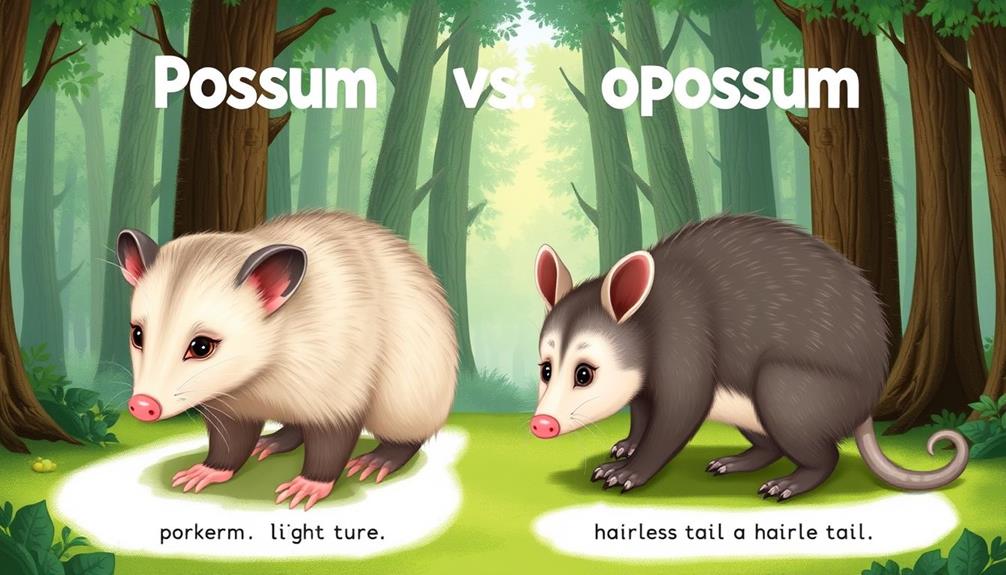
The taxonomic classification of possums and opossums reveals fascinating differences between these two marsupials.
Possums belong to the order Diprotodontia, which includes around 155 species, such as kangaroos and koalas. You'll find these animals primarily in Australia and surrounding regions, where their unique adaptations, similar to the preservation of traditions among the Hopi tribe, play a vital role in their survival.
In contrast, opossums fall under the order Didelphimorphia, comprising over 110 species, with a strong presence in the Americas.
One notable species is the Virginia opossum, scientifically known as Didelphis virginiana. This classification emphasizes the distinct evolutionary pathways these two groups have taken.
While possums are more closely related to other marsupials like koalas and wallabies, opossums represent a unique lineage within the marsupial family.
The geographical separation of these animals also plays a role in their classification. Possums thrive in the Southern Hemisphere, whereas opossums inhabit North America.
Understanding these taxonomic distinctions helps clarify the rich diversity of marsupials. By recognizing their classifications, you gain insight into how these fascinating creatures adapt to their environments and the evolutionary history that shaped them.
Physical Characteristics
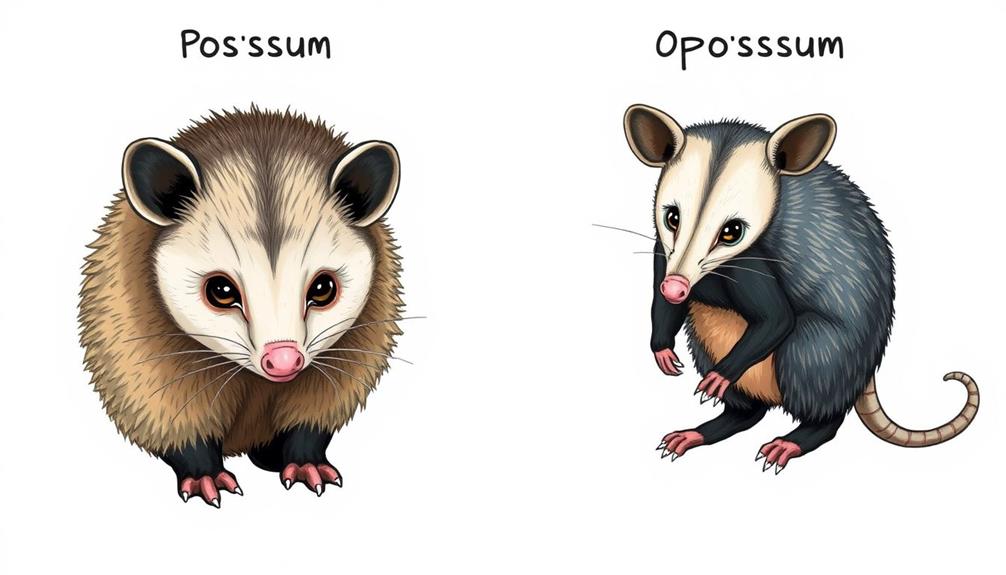
When you look at possums and opossums, their distinctive facial features immediately stand out.
You'll notice that possums have rounded faces and larger eyes, while opossums sport pointed snouts and coarse fur.
Additionally, their tail structures and sizes vary greatly, with possums having bushy tails compared to the hairless tails of opossums.
Curiously, just like many animals, these creatures also have unique behavioral traits that can be observed in their interactions within their environments, similar to how cats display emotional connections.
Distinctive Facial Features
Distinctive facial features set possums and opossums apart, making it easy to identify each. When you look closely at a possum, you'll notice its softer, rounder face, complemented by larger, expressive eyes. This gives possums a more gentle appearance.
In contrast, opossums sport pointed white faces with prominent black eyes and elongated snouts, lending them a fiercer look. Some dog breeds, like the Maltipoo names, also exhibit unique facial traits that can be intriguing.
The fur color of possums varies widely, from golden to gray, brown, black, or white, adding to their diverse aesthetic. Opossums, however, are generally gray and characterized by coarse fur, which contributes to their more rugged appearance.
When it comes to teeth, opossums have sharp, jagged teeth that enhance their fierce demeanor, while possums have less prominent teeth that align with their softer look.
Tail Structure Variations
Tail structure plays a crucial role in distinguishing possums from opossums. The tail variations reflect their different lifestyles and adaptations to their environments.
Possums possess prehensile tails that act as a fifth limb, enabling them to grip branches securely while climbing. This feature showcases their arboreal adaptation, allowing them to navigate trees with ease. In addition to their physical adaptations, understanding plant properties and sustainability is essential for those interested in nature and wildlife, including the study of essential knowledge for herbalism.
In contrast, opossums have long, hairless, rat-like tails that are less suited for gripping. These tails primarily aid in balance, making them ideal for a more ground-oriented existence.
Consider these visual differences in their tails:
- Possums' tails: Thick, furry, and capable of grasping tree limbs.
- Opossums' tails: Long, thin, and mostly hairless, streamlined for terrestrial movement.
- Functionality: Possums use their tails for climbing, while opossums rely on theirs for stability on the ground.
These tail structure variations highlight how possums and opossums have adapted to their respective habitats, showcasing the diversity within the marsupial family. Understanding these differences can deepen your appreciation for these fascinating creatures.
Size Comparison Differences
Understanding the size differences between possums and opossums adds another layer to your knowledge of these marsupials. When you look at the size comparison, you'll notice a distinct difference in their physical characteristics. Possums can vary considerably in size, weighing anywhere from under an ounce to over 20 pounds. The average brushtail possum weighs around five pounds. In contrast, opossums have a more uniform size, typically ranging from 8.8 to 13.2 pounds, and can reach lengths of up to 2.5 feet from nose to tail.
Here's a quick visual representation:
| Aspect | Possums | Opossums |
|---|---|---|
| Weight Range | <1 oz to 20 lbs | 8.8 to 13.2 lbs |
| Average Weight | ~5 lbs | 10 lbs |
| Body Shape | Rounded | Elongated |
These size differences reflect how each group has adapted to various environments and lifestyles. While possums have rounded bodies, opossums boast more elongated bodies and pointed snouts, showcasing their unique adaptations.
Size Comparison
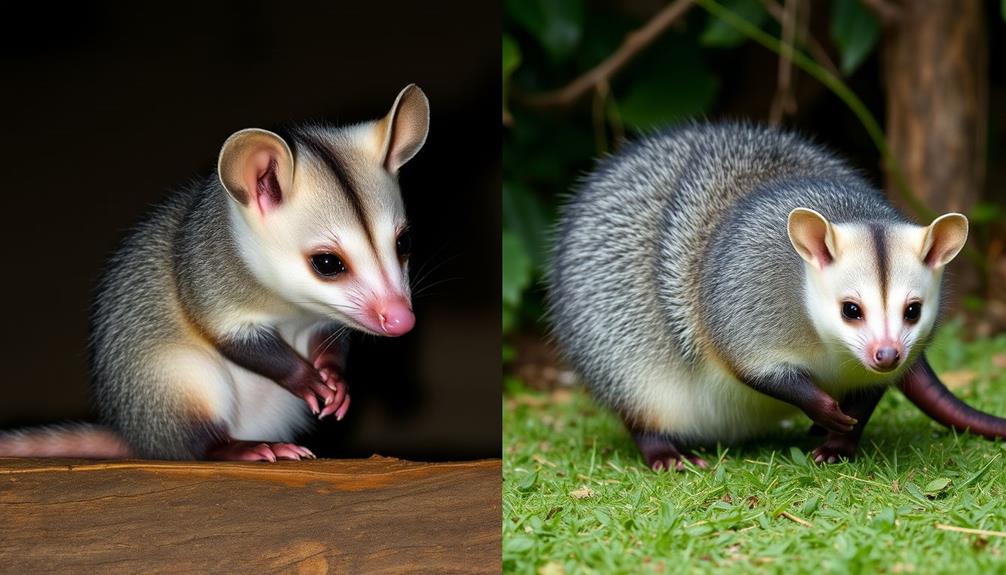
When you compare the sizes of possums and opossums, you'll notice some clear differences.
Possums can weigh less than an ounce to around five pounds, while opossums typically weigh between 8.8 and 13.2 pounds.
This distinction in size can be compared to the varying impacts of different types of narcissism, as seen in the impact of narcissistic abuse.
This weight distribution, along with their lengths, shows that opossums are generally larger and more robust than their possum relatives.
Average Size Comparison
Possums and opossums may look similar at first glance, but their sizes reveal distinct differences. When you compare the average size of these two marsupials, you'll notice that possums are generally smaller and lighter than opossums.
This size variation is reminiscent of the Tiny House Movement, which emphasizes minimalist living and efficient use of space, allowing individuals to thrive in smaller environments while reducing their ecological footprint. In a similar way, the compact nature of possums highlights the diversity found within the marsupial family the significance of minimalism.
- Possums can weigh anywhere from under an ounce to over 20 pounds, with the average brushtail possum around five pounds.
- Opossums, on the other hand, typically weigh between 8.8 to 13.2 pounds and measure about 2.5 feet in length.
This size difference is essential for identifying these animals in the wild.
While possums exhibit a wide range of sizes among species, most are less bulky and more lightweight than their North American cousins, the opossums. If you encounter a possum, you're likely to see a smaller creature, whereas an opossum will present a more robust body.
Understanding these size differences not only helps in identification but also highlights the diversity within the marsupial family. So, next time you spot one, take a moment to appreciate how size plays a role in distinguishing these fascinating animals.
Weight Distribution Differences
Examining weight distribution differences reveals intriguing contrasts between possums and opossums.
You'll notice that possums, with around 70 species, show a wide variation in weight. They typically weigh between 0.5 to 20 pounds, and the average brushtail possum weighs about 5 pounds. This variability means you might encounter a possum that's quite small or one that's surprisingly hefty.
As you consider these differences, it's crucial to recognize the importance of a balanced diet and nutrition tips for maintaining healthy wildlife.
In contrast, opossums, especially the Virginia opossum, maintain a more uniform size range, weighing between 8.8 to 13.2 pounds. They can also reach lengths of up to 2.5 feet from nose to tail, giving them a more robust build.
This consistency in weight distribution among opossums makes them easier to categorize compared to the diverse sizes found in possums.
Behavior and Diet
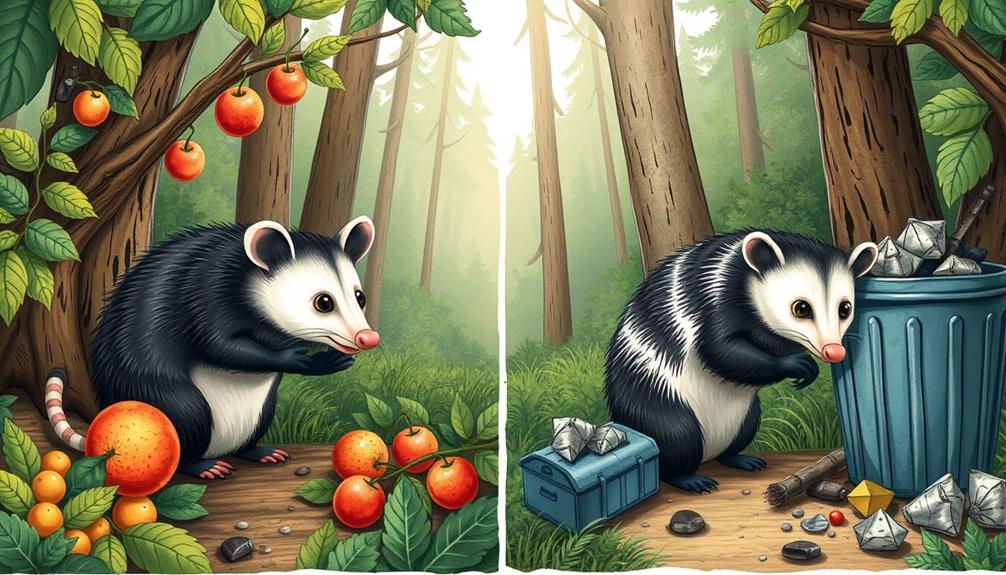
At night, both possums and opossums exhibit fascinating behaviors and dietary habits that reflect their adaptability to different environments.
While possums lean towards a herbivorous diet, munching on fruits, leaves, and flowers, opossums are omnivorous, indulging in a wider range of foods including:
- Juicy fruits and crunchy insects
- Small animals and the occasional carrion
- Leftover scraps from human habitats
This dietary flexibility makes opossums excellent scavengers, which in turn promotes their role in physical health and reduced obesity rates.
As nocturnal foragers, both creatures are most active after sunset, searching for meals under the cover of darkness. Possums tend to be solitary, while opossums can sometimes be spotted in small groups, thanks to their adaptable nature.
Opossums have an intriguing behavior when threatened: they can play dead, a defense mechanism that can last anywhere from a few minutes to four hours.
This unique survival tactic, combined with their stable populations, highlights how beneficial opossums are for pest control.
On the other hand, many possum species face threats from habitat loss and hunting, showcasing the differing challenges these two animals encounter in their respective environments.
Historical Background
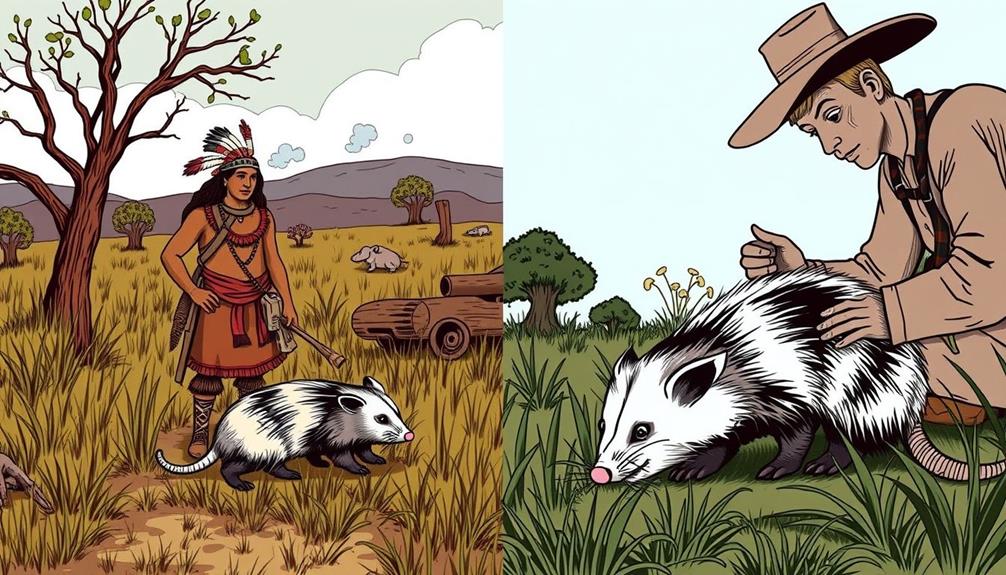
Understanding the historical context of possums and opossums sheds light on their unique identities. The term "opossum" first appeared in the 17th century, documented by Captain John Smith. It's derived from an Algonquian word meaning "white beast," a fitting description for these creatures. This early naming captures the connection between language and the natural world, emphasizing how cultures interpret their environments.
In exploring the cosmic connections between species, we can appreciate the diverse interpretations of beauty in nature.
Over a century later, Sir Joseph Banks identified possums in Australia and New Guinea, recognizing them as part of the Opossum tribe. This distinction became clearer through the historical context, illustrating the geographical separation of these marsupials. While opossums are native to the Americas, possums are found exclusively in Australasia.
Interestingly, early colonial spellings of "opossum" included variations like opassum and aposoum, showcasing the evolution of language as it adapted to new environments and encounters. This linguistic journey highlights the biological and geographical differences between these two groups, reinforcing that while they share a name, their identities are distinctly rooted in their respective ecosystems.
Understanding this history enriches your appreciation for both possums and opossums.
Common Misconceptions
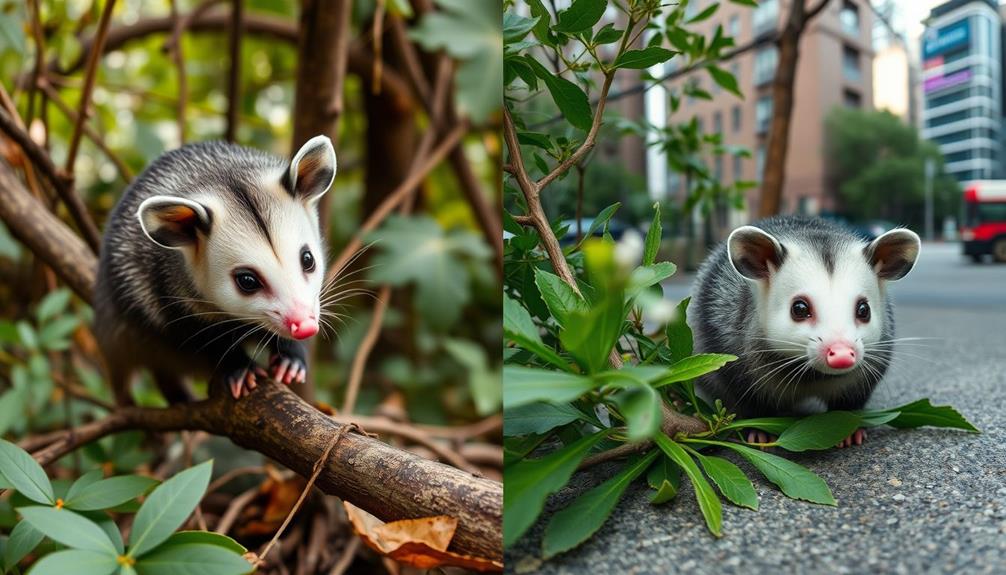
You might be surprised to learn that many people misuse the terms "possum" and "opossum" interchangeably, leading to confusion about these distinct animals.
It's easy to mix them up, especially since the Virginia opossum closely resembles possums in name and some physical traits.
Understanding the differences in both terminology and species can clear up a lot of misconceptions.
Misuse of Terminology
Many people mistakenly use the term "possum" to refer to opossums, leading to significant confusion about these two distinct groups of marsupials. The Virginia opossum, for example, is often misidentified in casual conversation, which can obscure its unique traits.
- Opossums have a pointed snout and a prehensile tail, perfect for grasping branches.
- Possums, on the other hand, are found in Australia and feature rounded faces and furry tails.
Recognizing these differences is essential for understanding their roles in ecosystems.
Misusing these terms not only creates confusion but also undermines conservation efforts. When you call an opossum a possum, you're misidentifying an important species—one that's unique to North America.
This mislabeling can hinder awareness and protection of both groups of marsupials, especially since the Virginia opossum is the only marsupial native to your region.
By using the correct terminology, you contribute to better education and conservation strategies, helping others appreciate the distinct characteristics of possums and opossums.
Species Identification Confusion
Species identification confusion often stems from the overlapping terminology used for possums and opossums. Many folks incorrectly call the Virginia opossum, the only marsupial native to North America, a "possum." This common misnomer leads to misunderstandings about these two distinct groups.
While both names sound similar, you're looking at different animals altogether.
Possums, native to Australia and nearby regions, belong to the order Diprotodontia. In contrast, opossums fall under the order Didelphimorphia. These taxonomic differences highlight a significant divergence that often gets overlooked. Misconceptions arise mainly due to the phonetic similarities in their names, which can be misleading.
You can also note their habitats to help clarify their identities. Possums are primarily tree-dwelling creatures, while opossums are more adaptable, thriving in both arboreal and terrestrial environments.
Recognizing these traits can help you distinguish between the two. So next time you see one, remember that not all marsupials are created equal—get familiar with the differences, and you'll enhance your understanding of these fascinating animals.
Spelling and Pronunciation
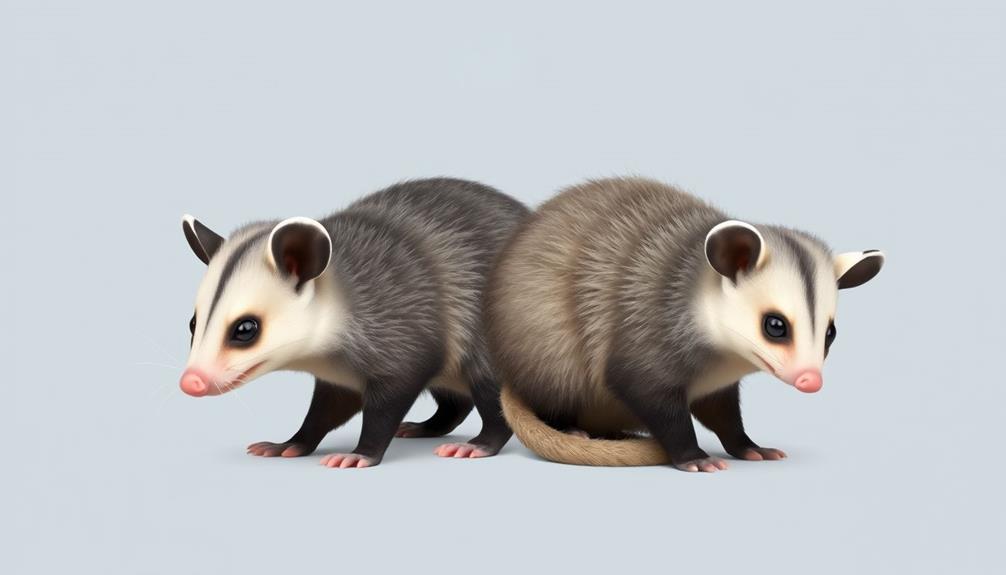
Understanding the spelling and pronunciation of "opossum" and "possum" is vital for clear communication. The term "opossum" is pronounced as uh-poss-uhm, while "possum" simplifies to poss-uhm in casual chat. This distinction might seem minor, but it helps convey the right meaning.
- The initial "o" in "opossum" sets it apart from "possum."
- Common misspellings like "opposum" or "opussum" can lead to confusion.
- Despite the difference, both terms refer to distinct groups of marsupials.
In North America, many people often drop the "o," leading to the colloquial use of "possum." However, knowing the correct spelling of "opossum" is important for clarity, especially in written communication.
Remember, both terms are singular forms, and when pluralized, simply add an "s" to each, resulting in "opossums" and "possums." By mastering the spelling and pronunciation, you'll enhance your conversations and avoid misunderstandings.
Importance of Terminology

The terminology you use when discussing marsupials matters more than you might think. Understanding the difference between "opossum" and "possum" is essential for clear communication. The term "opossum" specifically refers to the marsupials native to the Americas, particularly the Virginia opossum. In contrast, "possum" describes marsupials found in Australia and surrounding regions. Misusing these terms can lead to confusion since they belong to different taxonomic orders—Didelphimorphia for opossums and Diprotodontia for possums.
The importance of terminology extends beyond simple word choice; it aids in scientific accuracy and helps you grasp the ecological roles of these distinct groups. By using the correct terms, you prevent the misidentification of species in both casual conversation and academic discussions.
Conservation Status

While the distinction between "opossum" and "possum" is important for clear communication, it also highlights differing conservation statuses between these marsupials. Opossums, particularly the Virginia opossum, thrive in various environments and aren't currently at risk. Their adaptability helps maintain stable populations, offering benefits like pest control that aids ecosystems.
On the other hand, many possum species face serious threats due to habitat loss, hunting, and environmental changes. This has led to urgent conservation efforts aimed at protecting their natural habitats. The IUCN Red List categorizes several possum species as vulnerable or endangered, underscoring the need for immediate action.
To visualize the plight of possums, consider:
- Dense forests disappearing, leaving possums with nowhere to go
- Community initiatives restoring habitats, bringing hope back to these species
- Educational programs raising awareness about the importance of protecting wildlife
Conservation strategies for possums often include habitat restoration, public education, and legal protections. These initiatives are essential for ensuring that possums can survive and thrive in the wild, contrasting sharply with the stable status of their opossum relatives.
Frequently Asked Questions
Is There a Difference Between a Possum and an Opossum?
Yes, there's a difference between a possum and an opossum. You'll find possums in Australia and nearby regions, while opossums are native to the Americas, each with distinct physical features and behaviors.
Which Came First Possum or Opossum?
Imagine a language dance, where "opossum" twirled in first, stepping onto the scene in 1610. "Possum" followed, a playful partner named later—each name tells a tale of geography and time, don't you think?
What Are the Morphological Differences Between Opossum and Possum?
When you observe them, you'll notice possums have rounder bodies and thicker tails, while opossums feature elongated heads and hairless tails. Their fur colors also differ, with opossums being generally darker and coarser.
What Is the Difference Between a Possum Tail and an Opossum Tail?
A possum's tail's thick and furry, helping with warmth and grip, while an opossum's tail is hairless and slender, serving mainly for balance. You'll notice these key differences when observing them in nature.
Conclusion
In understanding the difference between possums and opossums, you're not just learning about animals; you're uncovering the rich tapestry of wildlife terminology. For instance, imagine coming across an opossum in your backyard, and instead of calling it a possum, you share your newfound knowledge with friends. You explain how it's unique to the Americas, while the possum thrives in Australia. This simple conversation can spark curiosity and appreciation for the diversity of life around us!
